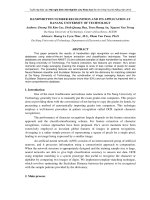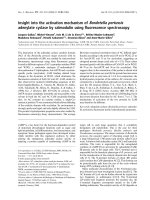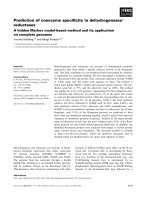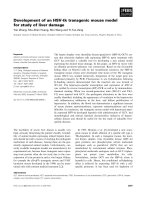Development of bordetella pertussis as a live vehicles for heterologous antigens delivery, and its application as a universal influenza a vaccine
Bạn đang xem bản rút gọn của tài liệu. Xem và tải ngay bản đầy đủ của tài liệu tại đây (2.15 MB, 258 trang )
DEVELOPMENT OF BORDETELLA PERTUSSIS AS A LIVE
VEHICLE FOR HETEROLOGOUS ANTIGEN DELIVERY,
AND ITS APPLICATION AS A UNIVERSAL INFLUENZA A
VACCINE
LI RUI
NATIONAL UNIVERSITY OF SINGAPORE
2010
DEVELOPMENT OF BORDETELLA PERTUSSIS AS A LIVE
VEHICLE FOR HETEROLOGOUS ANTIGEN DELIVERY,
AND ITS APPLICATION AS A UNIVERSAL INFLUENZA A
VACCINE
LI RUI
B.Sc.; M.Sc.
A THESIS SUBMITTED FOR THE DEGREE OF
DOCTOR OF PHILOSOPHY
DEPARTMENT OF MICROBIOLOGY
NATIONAL UNIVERSITY OF SINGAPORE
i
ACKNOWLEDGEMENTS
If you ask me which part of the thesis I have spent most of the time to write, I would say
it is the acknowledgements. In the past five years of my PHD study, there have been too
many people who have given me so much help that without them all these work never
have been possible. So, from the beginning to the end of my study, I am always thinking
how I would write the acknowledgements to express my sincere appreciation and thanks
to them.
First of all, I would like to express my deepest gratitude to my supervisor Assistant
Professor Dr Sylvie Alonso whose invaluable guidance as well as remarkable patience
have made this project possible. Your constant advice, encouragement and support has
inspired me and propelled my passion for research. You has been a most inspiring and
considerate supervisor throughout these five years of my research here. Besides research,
you have also showered me endless care and help in my life throughout these years. I
cannot thank you enough. The experience and knowledge gained from you will always
benefit my future and will always be embedded in my mind.
I am also very grateful to Associate Professor Vincent Chow and Sim Meng Kwoon for
their helpful suggestions and generous support in this project.
I would also like to express my special thanks to Annabelle, whose help has been
extremely valuable especially during the days when I was pregnant and away to give
birth to my baby. Special thanks also to Mrs Phoon Meng Chee, Dr Raju, Jowin and Wee
Peng, for their constant and great support and help to this project.
ii
I would also thank Mr Joe Tong and Mr Goh for their selfless help and support in
handling the administrative matters, which had helped a lot in the progress of this project.
I would also like to thank my friends in the lab, Siying, Wenwei, Lili, Stephanie, Adrian,
Grace, Wei Xin, Damian, Emily, Aakanksha, Regina, Weizhen, Jian Hang, Zarina,
Michelle, Vanessa, for the help they gave in various aspects. I have shared five cherished
years with you in a cozy environment. This wonderful time will always be a beautiful
memory in my life.
Special thanks are also addressed to Professor Camille Locht for providing the BPZE1
strain; Lew Fei Chuin and Weiqiang for their invaluable assist in FACS analysis; friends
in Professor Kemeny‟s lab, especially Richard, Benson, Kenneth and Yafang; friends in
Associate Professor Fred Wang‟s lab and Associate Professor Herbert Schwarz‟s lab; as
well as all those who have helped me in one way or another. I really appreciate it.
I am immensely grateful to my parents, my sister and brother, as well as my uncles for
their endless love, encouragement, support and belief in me all these years. It is your
love and support that has made me who I am today.
Last but not least, I would like to dedicate this thesis to
My husband Xu Yan and my dear baby Chenyu. Chenyu, my little angel, thank you for
accompanying me since last year, your lovely smile has made my life colorful and joyful
and let me forgot all the not so good times. Xu Yan, thank you so much for your endless
love, understanding and support throughout this project. Thank you for waiting there for
me. This piece of work is the fruit of our 5 years of separation. I will cherish it forever.
iii
TABLE OF CONTENTS
ACKNOWLEDGEMENTS i
TABLE OF CONTENTS iii
LIST OF FIGURES xiv
LIST OF TABLES xvii
ABBREVIATIONS xviii
SUMMARY xxiii
CHAPTER 1 INTRODUCTION 1
CHAPTER 2 SURVEY OF LITERATURE 5
(I) INFLUENZA VIRUSES 5
2.1 INFLUENZA MORBIDITY, MORTALITY AND HISTORY OF INFLUENZA
PANDEMICS 5
2.2 INFLUENZA VIRUSES CLASSIFICATION 6
2.3 INFLUENZA A VIRUS: STRUCTURE AND REPLICATION 7
2.3.1 Influenza A Virus Genome and Its Major Protein Products 7
2.3.2 Antigenic Shift and Drift 11
2.3.3 Determinants of Tissue Tropism and virulence 11
2.4 IMMNUE RESPONSE TO INFLUENZA A VIRUS INFECTION 16
2.4.1 Innate Immunity 16
2.4.2 Effector Mechanisms of the Adaptive Immunity 17
iv
2.4.3 Immune Correlates of Protection 20
2.4.3.1 Role of HA, NA and M2 specific antibodies in the protection of
influenza virus infection 20
2.4.3.2 Role of influenza specific cell mediated immunity in the protection of
influenza virus infection 24
2.5 INFLUENZA PATHOGENESIS 26
2.5.1 Clinical Presentations of Influenza and Links with Immune Dysregulation . 26
2.5.2 The “Cytokine Storm Theory”- Cytokines and Chemokines in Influenza
Immunopathology 27
2.5.3 CD4
+
and CD8
+
in Influenza Immunopathology 29
2.5.4 Alveolar Macrophages and Neutrophils in Influenza Immunopathology 31
2.6 OPTIONS FOR PANDEMIC CONTROL 34
2.6.1 Antivirals Treatment: Effectiveness and Limitations 34
2.6.2 Licensed and Trial Vaccines 36
2.6.2.1 Current licensed vaccines 37
2.6.2.1.1 Inactivated virus vaccines 37
2.6.2.1.2 Live attenuated virus vaccine- Cold attenuated vaccine (CAV) 38
2.6.2.1.3 Limitations of Current Licensed Vaccines 39
2.6.2.2 Alternative approaches to pandemic influenza vaccine development 40
2.6.2.2.1 Virosome-based influenza vaccines 40
v
2.6.2.2.2 DNA Vaccines 41
2.6.2.2.3 Recombinant Vectored Subunit Vaccines 42
2.6.3 Universal influenza virus vaccines 45
2.6.3.1 Ecto-domain of Matrix protein 2 (M2e) as a Universal Vaccine
Candidate 45
2.6.3.2 Nucleocapsid Protein (NP) as a Universal Vaccine Candidate 47
2.6.3.3 Conserved Neutralizing Epitopes of HA protein as Universal Vaccine
Candidates 48
(II) BORDETELLA PERTUSSIS AS A LIVE VEHICLE FOR HETEROLOGOUS
VACCINE ANTIGENS DELIVERY THROUGH THE NASAL ROUTE 50
2.7 MUCOSAL VACCINATION 50
2.7.1 Mucosal Immunity 50
2.7.2 Vaccination via the Mucosal Route 51
2.7.3 Intranasal Vaccination 52
2.8 BORDETELLA PERTUSSIS MICROBIOLOGY 53
2.8.1 Bordetella pertussis Pathogenesis and Whooping Cough 53
2.8.2 Treatment and Pertussis Vaccines 54
2.8.3 Virulence Determinants of B. pertussis 55
2.9 IMMUNITY TO B. PERTUSSIS 61
2.9.1 Humoral and Cell-mediated Immunity 61
vi
2.9.2 Immune Subversion and Immunomodulatory Effects of B. pertussis 64
2.10 ATTENUATED B. PERTUSSIS FOR HETEROLOGOUS ANTIGEN
DELIVERY 67
2.10.1 Live Bacteria as Vaccine Delivery System 67
2.10.2 Attenuated B. pertussis as a Live Recombinant Nasal Delivery Vector 68
2.10.3 FHA as an Antigen Carrier 70
2.10.4 Other Antigen Carriers 72
CHAPTER 3 MATERIALS AND METHODS 74
(I) ESCHERICHIA COLI WORK 74
3.1 BACTERIAL STRAINS, PLASMIDS AND GROWTH CONDITIONS 74
3.1.1 E. coli Strains and Plasmids 74
3.1.2 Growth Conditions 75
3.2 MOLECULAR BIOLOGY 76
3.2.1 Oligonucleotides and Primers 76
3.2.1.1 List of oligonucleotides and primers 76
3.2.1.2 Hybridization of oligonucleotides 76
3.2.2 Plasmid Extraction 79
3.2.3 Polymerase Chain Reaction (PCR) 79
3.2.3.1 DNA amplification 79
3.2.3.2 Colony PCR screening 79
vii
3.2.4 Restriction Enzyme Digestion 80
3.2.5 Agarose Gel Electrophoresis 80
3.2.5.1 Gel migration 80
3.2.5.2 Gel extraction 81
3.2.6 DNA Cloning 81
3.2.7 Transformation of Chemically Competent E. coli 82
3.2.8 DNA Sequencing 82
(II) BORDETELLA PERTUSSIS WORK 83
3.3 BACTERIAL STRAINS AND GROWTH CONDITIONS 83
3.3.1 B. pertussis Strains 83
3.3.2 Growth Conditions 84
3.4 MOLECULAR BIOLOGY 84
3.4.1 List of Primers 84
3.4.2 Construction of Recombinant B. pertussis Strains 85
3.4.2.1 Construction of Recombinant B. pertussis Strains Expressing M2e, HA
1-1
,
HA
2-1
and HA
2-2
85
3.4.2.1.1 Design and synthesis of optimized m2e (opm2e), ha
1-1
(opha
1-1
), ha
2-
1
(opha
2-1
) and ha
2-2
(opha
2-2
) 85
3.4.2.1.2 Cloning opm2e, opha
1-1
, opha
2-1
and opha
2-2
into fhaB 87
viii
3.4.2.1 Construction of Recombinant B. pertussis Strains Expressing ∆NA and NP
90
3.4.2 Transformation of B. pertussis 92
3.4.2.1 Preparation of electrocompetent cells 92
3.4.2.2 Electroporation of plasmid DNA into B. pertussis 92
3.4.4 Screening for True Recombinants 93
3.5 PROTEIN EXPRESSION STUDIES 94
3.5.1 Preparation of B. pertussis Samples 94
3.5.1.1 Supernatant 94
3.5.1.2 Cell extract 94
3.5.2 Sodium Dodecyl Sulphate-Polyacrylamide Gel Electrophoresis 95
(SDS-PAGE) 95
3.5.3 Coomassie Blue Staining 95
3.5.4 Western Blot 96
(III) ANIMAL WORK 98
3.6 MOUSE STRAINS 98
3.7 PRODUCTION OF POLYCLONAL ANTI-M2E IMMUNE SERA 98
3.8 INTRANASAL B. PERTUSSIS INFECTION 99
3.9 LUNG COLONIZATION STUDY 99
3.10 IN VIVO STABILITY STUDIES 99
ix
3.11 STUDY OF THE IMMUNE RESPONSES 100
3.11.1 Immunization Schedules 100
3.11.2 Broncho-alveolar Lavage Fluids (BALFs) and Serum Collection 101
3.12 INFLUENZA VIRUS INFECTION 101
3.13 HISTOPATHOLOGY 102
3.13.1 Histopathology of Mouse Lungs 102
3.13.2 Cellular Infiltrates in Bronchoalveolar Lavage Fluids (BALFs) 102
3.14 PASSIVE TRANSFER PROTECTION STUDY 102
(IV) VIRUS WORK 104
3.15 VIRUS STRAINS 104
3.16 VIRUS TCID
50
QUANTIFICATION 104
3.17 IN VITRO MICRO-NEUTRALIZATION ASSAY 105
(V) IMMUNOLOGY WORK 106
3.18 ENZYME-LINKED IMMUNOSORBENT ASSAY (ELISA) 106
3.18.1 Coating Antigens 106
3.18.2 Determination of Antibody Titer 106
3.19 IN VITRO RE-STIMULATION EXPERIMENTS 108
3.19.1 T-Cell Proliferation assay 108
3.19.2 IFN-γ ELISPOT 109
3.20 MULTI-PLEX CYTOKINE AND CHEMOKINE ANALYSIS 109
x
3.21 FACS ANALYSIS 110
(VI) STATISTICAL ANALYSIS 110
CHAPTER 4: STUDY OF THE MECHANISMS INVOLVED IN THE
PROTECTION OF ATTENUATED B. PERTUSSIS BPZE1 AGAINST LETHAL
INFLUENZA A VIRUS CHALLENGE 111
4.1 RESULTS 111
4.1.1 A Single Nasal Treatment with B. pertussis BPZE1 Protects Against Lethal
Challenge with Mouse-Adapted H3N2 Virus 111
4.1.2 Booster Effect 116
4.1.3 BPZE1 Protects Against H1N1 Virus 118
4.1.4 BPZE1 Treatment Protects Mice from Influenza-induced Immunopathology
and Lymphocyte Depletion 120
4.1.5 B. pertussis-specific Adaptive Immunity is Not Involved in Protection against
Influenza A Virus 123
4.1.6 The Viral Load is Not Significantly Reduced in BPZE1-treated Mice 126
4.1.7 The Production of Major Pro-inflammatory Cytokines and Chemokines is
Dampened in the Protected BPZE1-treated Mice 128
4.2 DISCUSSION 131
CHAPTER 5 DEVELOPMENT OF A UNIVERSAL VACCINE AGAINST
INFLUENZA A VIRUSES 138
5.1 RESULTS 138
xi
5.1.1 STUDIES OF RECOMBINANT B. PERTUSSIS STRAINS EXPRESSING
THE ECTODOMAIN OF MATRIX PROTEIN 2 (M2E) 138
5.1.1.1 Construction of Recombinant B. pertussis Strains Producing FHA-
(M2e)
1,2,3
Chimera 138
5.1.1.2 Lung Colonization by the Recombinant B. pertussis Strains 140
5.1.1.3 Specific Antibody Responses Elicited by the Recombinant B. pertussis
Strains 143
5.1.1.4 Expression of the FHA-(M2e)
3
Chimera in a dsbA Knockout B. pertussis
Background 147
5.1.1.5 Colonization Efficacy, Bacterial Fitness and Immunogenicity of the
dsbA
BPST6 mutant 149
5.1.1.6 Protection Efficacy of Recombinant B. pertussis (BPLR3) Producing
FHA-(M2e)
3
Chimera against Influenza Challenge 154
5.1.1.7 Isotyping of Systemic and Local anti-M2e IgG Antibodies in the
Immunized Mice 158
5.1.2 STUDIES OF RECOMBINANT B. PERTUSSIS STRAINS EXPRESSING
EPITOPES FROM THE HAEMAGGLUTININ (HA) 161
5.1.2.1 Production of FHA-(HA1-1)
7
, FHA-(HA2-1)
3
and FHA-(HA2-2)
3
Chimera by Recombinant B. pertussis 161
5.1.2.2 Specific Antibody Responses Elicited by the Recombinant B. pertussis
Strains Expressing HA1-1, HA2-1 and HA2-2 Epitopes 163
xii
5.1.3 STUDIES OF RECOMBINANT B. PERTUSSIS STRAINS EXPRESSING
NUCLEOCAPSID PROTEIN (NP) 165
5.1.3.1 Detection of NP Expressed in Recombinant B. pertussis Strains 165
5.1.3.2 In vivo Stability Studies 166
5.1.3.3 Immune Responses Elicited by Recombinant B. pertussis Strains
Expressing NP 167
5.1.4 STUDIES OF RECOMBINANT B. PERTUSSIS STRAINS EXPRESSING
TRUNCATED NEURAMINIDASE (ΔNA) 170
5.1.4.1 Detection of ΔNA Expressed in Recombinant B. pertussis Strains 170
5.1.4.2 Immune Responses Elicited by Recombinant B. pertussis 174
5.2 DISCUSSION 176
5.2.1 POTENTIAL OF ATTENUATED B. PERTUSSIS BPZE1 AS LIVE
VACCINE DELIVERY VECTOR AGAINST INFLUENZA A VIRUS: FHA AS A
CARRIER FOR HETEROLOGOUS ANTIGEN TO BE SECRETED INTO THE
EXTRACELLUAR MILIEU 176
5.2.1.1 Recombinant B. pertussis Expressing M2e 176
5.2.1.2 Recombinant B. pertussis Expressing HA Epitopes 181
5.2.2 CYTOPLASMIC EXPRESSION OF ∆NA AND NP IN B. PERTUSSIS 183
CHAPTER 6 CONCLUSIONS AND FUTURE DIRECTIONS 188
6.1 CONCLUSIONS 188
6.2 FUTURE DIRECTIONS 191
xiii
REFERENCES A
APPENDICES
PUBLICATIONS
xiv
LIST OF FIGURES
Figure 2.1 Structure and immunogenicity of the influenza A virus. 10
Figure 2.2 Determinants of tissue tropism and virulence of influenza virus. 15
Figure 2.3 Structure of Matrix protein 2 23
Figure 2.4 B. pertussis virulence factors 56
Figure 3.1 Schematic diagram showing the 1620-bp HindIII-HindIII fhaB fragment
cloned into pBRSY0. 88
Figure 3.2 Overview of cloning strategy for FHA-(M2e)
1,2,3
89
Figure 3.3 Overview of cloning strategy for P
FHA
-∆NA 91
Figure 3.4 Western blot transfer sandwich. 96
Figure 4.1(A-D) Protection rates of BPZE1-treated mice against lethal challenge with
influenza A viruses. 113
Figure 4.2 Lung colonization profile of BPZE1. 114
Figure 4.3 Effect of the bacterial dose on BPZE1 protective efficacy against lethal
challenge with H3N2 virus. 115
Figure 4.4 Booster effect 117
Figure 4.5 Protective efficacy of BPZE1 against H1N1 A/PR8/34 influenza virus. 119
Figure 4.6 (A-C) Lung histology, cellular infiltrates and CD3
+
T-cell population in the
lungs of BPZE1-treated versus control mice. 122
Figure 4.7 (A-C) Cross-reactive antibodies in ELISA and neutralization assays. 124
Figure 4.8 (A-C) Cross-protective antibodies and T-cells. 125
Figure 4.9 Viral load quantification in the lungs of protected and non-protected mice. 127
Figure 4.10 Pro- and anti-inflammatory cytokine and chemokine profiles. 130
xv
Figure 5.1 SDS-PAGE and Coomassie staining and Western blot analysis of M2e
expressing recombinant B. pertussis. 139
Figure 5.2 Lung colonization profiles of M2e expressing B. pertussis strains. 141
Figure 5.3 In vitro growth kinetic of M2e expressing B. pertussis strains. 142
Figure 5.4 Detection of anti-B. pertussis local and systemic immune responses in mice
immunized with M2e-expressing B. pertussis strains 145
Figure 5.5 Detection of anti-M2e local and systemic immune responses in mice
immunized with M2e-expressing B. pertussis strains 146
Figure 5.6 Western blot analysis of 10× concentrated culture supernatant from BPLR3,
BPST6 (ΔdsbA), and parental BPZE1. 148
Figure 5.7 A Lung colonization ability of BPST6 strain. 150
Figure 5.7 B In vitro growth kinetics of BPST6 strain. 151
Figure 5.8 Anti-pertussis (A, B and C) and anti-M2e (D, E, and F) local and systemic
immune responses in mice immunized with BPST6 strains. 153
Figure 5.9 Survival rate (A) and average body weight changes (B) of naïve (solid circles),
BPZE1 (solid triangles), BPLR3 (open circles), KLH-M2e (open squares) and HI-H1N1
virus (solid squares) immunized mice challenged with 4 LD50 H1N1 viruses. 156
Figure 5.10 Viral load quantification in the lungs of naïve mice, BPZE1 immunized mice,
BPLR3 immunized mice and KLH-M2e immunized mice challenged with H1N1
influenza virus. 157
Figure 5.11 SDS-PAGE and Coomassie staining of non-concentrated culture supernatant
from parental BPZE or recombinant B. pertussis strains. 162
xvi
Figure 5.12 Local anti-HA1-1 IgA immune response in BALB/c mice upon nasal
administration of BPLR4. 164
Figure 5.13 Western blot analysis of whole cell extracts from parental strain BPDY2 and
recombinant B. pertussis expressing NP. 165
Figure 5.14 In vivo stability studies of BPLR7. 166
Figure 5.15 T-cell proliferation assay from mice immunized with BPLR7. 168
Figure 5.16 IFN-γ ELISPOT assay using splenocytes from mice immunized with BPLR7.
169
Figure 5.17 Selection of truncated NA by DNASTAR software. 172
Figure 5.18 Detection of ∆NA in recombinant B. pertussis 173
Figure 5.19 Detection of anti- ΔNA local and systemic immune responses in mice
immunized with ΔNA -expressing B. pertussis strain BPLR8. 175
xvii
LIST OF TABLES
Table 2.1 Criteria of the European Medicines Agency (EMEA) of the EU for the
evaluation of influenza vaccine efficacy 23
Table 2.2 Functions of B. pertussis virulence factors 57
Table 2.3 Antibody and cell-mediated responses to B. pertussis and pertussis vaccines . 63
Table 3.1 E. coli strains and plasmids 74
Table 3.2 Oligonucleotides and primers used for E. coli work. 77
Table 3.3 B. pertussis strains. 83
Table 3.4 Primers used for B. pertussis work. 84
Table 3.5 Optimized oligos of m2e, ha1-1, ha2-1 and ha2-2 86
Table 3.6 Antibodies used in Western Blot. 97
Table 5.1 Serum and BALFs anti-M2e IgG isotype 160
Table 5.2 Characteristics of recombinant B. pertussis strains expressing H5 epitopes. . 162
xviii
ABBREVIATIONS
aa Amino acid
AC Adenylate cyclase
ACE 3-amino-9-ethyl-carbazole
ACT Adenylate cyclase toxin
ADCC Antibody-Dependent Cellular Cytoxicity
ADP Adenosine diphosphate
AMs Alveolar macrophages
Amp Ampicillin
APS Ammonium persulphate
APC Antigen-presenting cell
BALFs Broncho-alveolar lavages fluids
BALT Bronchial-associated lymphoid tissue
BCG Bacillus Calmette-Guerin
BG Bordet-Gengou
bp Base pair
BSA Bovine serum albumin
Bvg Bordetella virulence gene
BvgA-P Phosphorylated BvgA
CFU Colony forming unit
CO2 Carbon Dioxide
CPE Cytopathic effect
xix
CRD Carbohydrate recognition domain
CTL Cytotoxic T-Lymphocyte
DC Dendritic cell
DNA Deoxyribonucleic acid
DNT Dermonecrotic toxin
DTaP vaccine Diphtheria-Tetanus-Pertussis (acellular)
vaccine
DTP vaccine Diphtheria-Tetanus-Pertussis (whole-cell)
vaccine
E. coli Escherichia coli
ELISA Enzyme-linked immunosorbent assay
FACS Fluorescence-activated cell sorting
FCS Fetal calf serum
FHA Filamentous haemagglutinin
g Gram
GALT Gut-associated lymphoid tissue
Gm Gentamicin
GRAS Generally recognized as safe
GTP Guanosine triphosphate
h Hour
H2O Water
HPAI Highly pathogenic avian influenza
HRP Horseradish peroxidase
xx
IFN-γ Interferon-gamma
Ig Immunoglobulin
IL Interleukin
i.m. Intramuscular
i.n. Intranasal
i.p. Intraperitoneal
Kan Kanamycin
kb Kilobase
kDa Kilodalton
l Liter
LB Luria-Bertani
LD50 Lethal dose 50
LPS Lipopolysaccharide
µg Microgram
µl Microliter
MALT Mucosa-associated lymphoid tissue
M cell Microfold cell
MHC Major histocompatibility complex
min Minute
ml Milliliter
MW Molecular Weight
NALT Nasal-associated lymphoid tissue
ng Nanogram
xxi
NK cell Natural killer cell
Nt Nucleotide
Ω Ohm
OD Optical density
OPD o-phenylenediamine dihydrochloride
PBS Phosphate-buffered saline
PCR Polymerase chain reaction
Pfha Promoter of FHA
PMN Polymorphonuclear leukocytes
PT Pertussis toxin
RE Restriction enzyme
RGD Arginine-glycine-aspartate
RNA Ribonucleic acid
rpm Revolution per min
s Second
SDS-PAGE Sodium dodecyl sulphate-polyacrylamide
gel electrophoresis
SP Signal peptide
S. typhi Salmonella typhi
Ta Annealing temperature of primers
TAE Tris-acetate
TCID50 Tissue culture infectious dose 50
TEMED Tetramethylethylenediamine
xxii
Th T-helper
TLR Toll-like receptor
TNF-α Tumour necrosis factor-alpha
TPS Two-Partner Secretion
Tr T-regulatory
TTFC Tetanus toxin fragment C
UV Ultraviolet
V Volt
vags virulence-activated genes
Vras Virulence-repressed antigens
vrgs virulence-repressed genes
WHO World Health Organization
xxiii
SUMMARY
Bordetella pertussis, a strict human pathogen, is the causative agent of whooping
cough. As a pathogen naturally infecting the respiratory tract, B. pertussis is particularly
well adapted for the nasal delivery of heterologous vaccines candidates and has already
been reported as a promising mucosal vaccine delivery system. Recently, a highly
attenuated B. pertussis strain, BPZE1, has been engineered. In addition, BPZE1 has
entered phase I clinical trial in humans as live pertussis vaccine. Although highly
attenuated as evidenced by a markedly reduced lung inflammation in the infected animals,
BPZE1 bacteria still maintain the ability to colonize the mice lungs efficiently and induce
protective immunity against pertussis infection. These features make BPZE1 strain not
only an attractive live pertussis vaccine candidate but also a potential vehicle for vaccine
delivery via the nasal route.
In this study, H5N1 specific antigen candidate NA, and several other antigens that
are highly conserved among influenza A viruses, namely the ectodomain of M2 protein
(M2e), 3 conserved neutralizing epitopes in H5 and the nucleocapsid protein (NP) were
selected and expressed in attenuated B. pertussis BPZE1. These antigens were either
expressed in the cytoplasm of B. pertussis or secreted into the external milieu using the
filamentous hemagglutinin (FHA) as carrier.
Unexpectedly, we observed in this study that prior nasal administration of an
attenuated strain of BPZE1 provided effective and sustained protection against lethal
challenge with mouse-adapted H3N2 influenza A virus. No significant protection was
observed in the mice pre-treated once with BPZE1 and challenged 3 weeks later whereas









